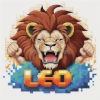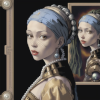Excellence consists of complex ideas communicated with clarity, precision, and efficiency and that is just as trues of the new media as of the old
Edward R. Tufte
Information design as a discipline is a fairly recent development, though one can trace its history back centuries. An information designer (to use an informal term) is a "transformer of information", who has the responsibility to select, organize, and present information to reveal its essence (Wildbur and Burke, 1998). His or her task is to help us see the "difference that makes a difference" (Gregory Bateson).
For some reason, I take great pleasure in seeing technical drawings, charts, diagrams, etc. I'm particularly fond of seeing complex information distilled to its constituent elements. While thinking about this, I created the orchid attached to this post using generative art software.
AI software is going to make things a lot of fun in the coming years. It will be able to analyze volumes of data and present information in an easy to understand graphical manner. It will be important that the results be presented as accurately and unbiased as possible; this being one of the hallmarks of good information design. I think AI can do this, but I'm not so sure about humans. It's impossible for a human not to be biased. So, we might find ourselves in some sticky situations in the not so distant future.
I imagine that online users will have to become more familiar with the elements of information design to protect themselves against biases and inaccuracies that may sway them into unwanted beliefs/behaviors. Technology is advancing in leaps and bounds, and I get the feeling that we're all playing catchup with this runaway train with a mind of its own.

Resource
Wildbur, Peter, and Michael Burke. 1998. Information Graphics: Innovative Solutions in Contemporary Design. Thames and Hudson.
 |  |  |  |
|---|---|---|---|
| X | InLeo | NFT Showroom |
Posted Using InLeo Alpha


